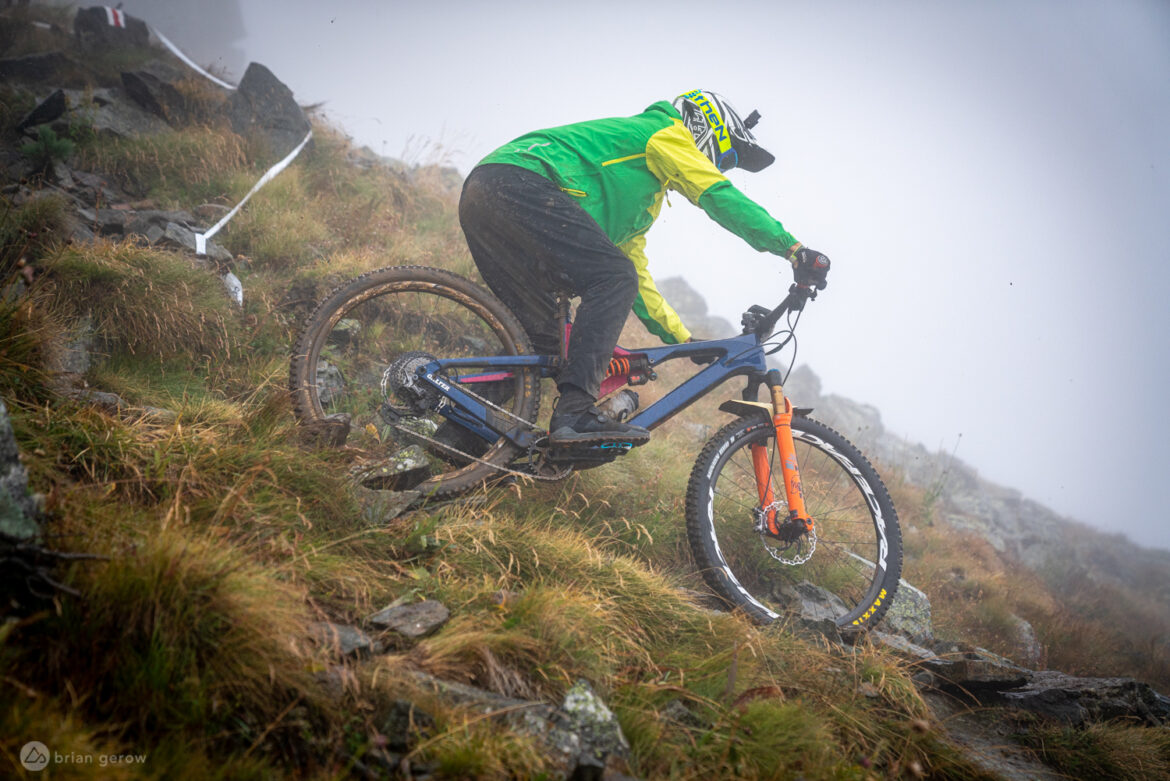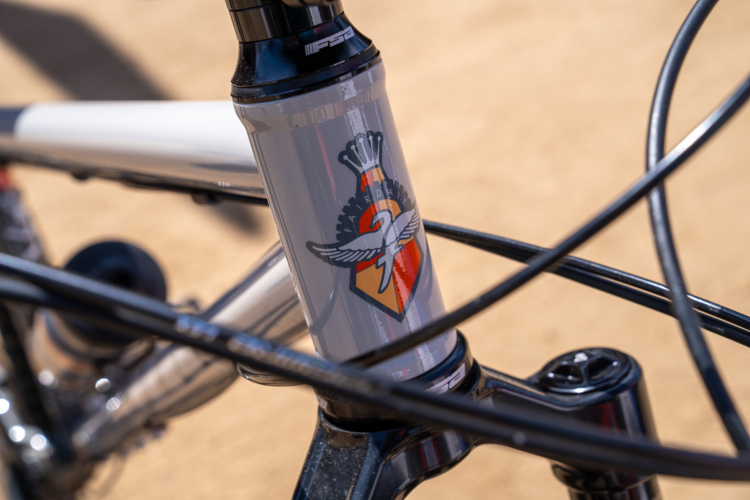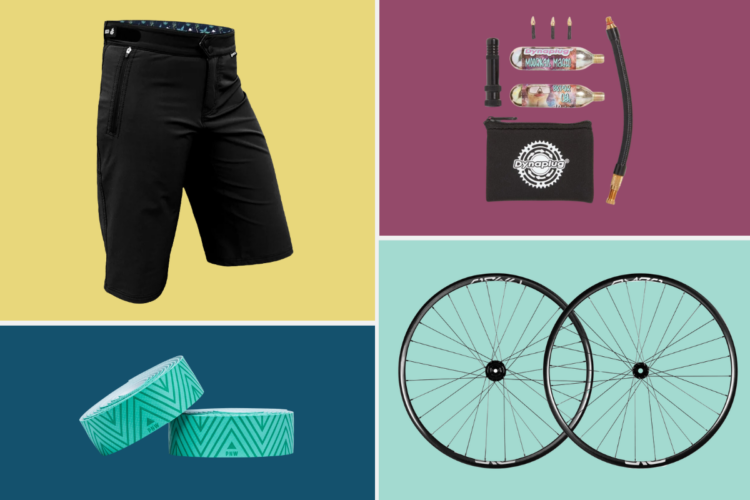
When the word “enduro” slid up to page one of the marketing department’s dictionary there was a specific bright-blue hue that decorated everything in the back of a Toyota Tacoma. You could tell if someone raced enduro, or wanted you to think they did, by the color of their kit and grips. Later it shifted to bright orange. Eventually, the “so enduro” sensation moved on to more practical elements, like DH tires and hip packs.
Today, anyone can go buy a proper enduro race bike that’s been defined and refined over nearly two decades of racing. While gravel bikes have taken over the bike industry’s fad space of late, there will forever be new trends in gravity gear to check out.
Coil-sprung shocks and forks are by no means new technology in the gravity racing world, but loads of riders are considering a coil purchase to redefine their stock enduro sleds. We asked several MTB suspension experts to share their thoughts on coil-sprung squish with the hope that we can all be a little better informed before trading stacks of hard-earned scrilla for a spring. Their insights and technical tips are illuminating.


The interview responses below were edited for length and clarity.
Advantages of coil-sprung suspension
If you’ve tried a modern coil-sprung fork or shock you likely sensed a few advantages, apart from the cool looks of that thick spiral of metal. The consistency on long, rough trails is unbeatable, and the initial stroke sensitivity can’t be matched. The suspension technicians we chatted with had a few perks to add to the list.
Franco Fratton, Technical Director at Extreme Shocks, points out that coil shocks reduce friction compared to air shocks. “The only real advantage I can think of in today’s MTB fork application could be the lack of friction coming from the mechanical system and better linear characteristics compared to air.”
According to Fabien Giatre of Fast Suspension, in addition to reduced friction, coils offer better “comfort, [..] no air leak, good mid-stroke support, and [they’re] linear.”
Thomas Westfeldt of Öhilins echos Franco and Fabien, saying “coil shocks have a lower friction and breakaway force in general.” He adds that riders “will get a very consistent performance from a coil shock and it is sensitive.”
Like most things in mountain biking, it’s clear the advantages depend on the bike and rider. If the leverage curve on your bike is progressive, a coil shock can give the bike a smoother initial suspension feel that’s consistent and predictable throughout the stroke. Also, coil forks and shocks require very little energy to initiate the stroke, which can improve traction.
Disadvantages of coil springs compared to air
Weight
Coils are heavier than air. However, there are things that can be done to reduce the weight of coil components, for example swapping for lighter-weight materials like titanium.
Fabien says, “There is only one way to save grams on springs. Find the best material to make the spring! It’s mostly in Japan. Our springs use Japanese raw material and they are made in Taiwan by Ichu.”
It’s also possible to re-design the spring itself. “Our SLS spring is hollow and is a good percentage lighter than a stock spring,” says Tyrone Dines from Fox Suspension.
Adjustability
Tyrone notes that the lack of adjustability associated with coil suspension can be a turn off for many buyers. “The customer gets pretty grumpy when they find out they have to shell out another bunch of cash for the correct springs.”
Getting the right amount of sag involves purchasing the correct spring weight, and riders may find they are in between weights, making it difficult to dial in precise sag like they can with an air shock. Öhlins is able to mitigate this a bit by offering coils with narrower, 4lb. incremental spring rates.
For coil-based forks, there are additional sag and tuning considerations. For example, Singletracks recently reviewed an Öhlins coil-sprung fork, and the setup instructions advised using the spring preload to adjust the static sag. We were surprised, since we’ve also heard that spring preload in a fork or shock only changes the amount of energy required to get the spring moving, also called breakaway force — and that the adjustment otherwise doesn’t affect suspension much. The sag in coil suspension is set by changing the physical spring, just like adding or removing pressure in an air-sprung fork or shock. Fortunately, the folks at Öhlins shared a little more on preload, as did other brands that approach sag and preload from different angles.
“First, we are setting sag with choosing the correct spring rate for the rider based on weight and riding style,” explains Thomas from Öhlins. “The preload is for fine-tuning sag and adjusting the balance of the bike. It can also be used to change characteristics for different types of riding. Technically you are altering the balance between the top-out spring and the main spring, that adjusts sag and ride height.”
Tyrone from Fox notes there are additional things to consider when using this method. “With a coil you can add in more preload, this will keep the fork up, heightwise, but of course it doesn’t make the fork stiffer, it just holds it up more. Its pre-load is simply the amount a spring is compressed when the fork is fully extended, but a 50lb spring with 10 turns of preload is still just a 50lb spring. In order to get a reference for the pre-load, you’d need to take the weight of the bike, rider, and the spring travel and work out a few figures.”
Sag and pre-load are complicated with coil shocks because riders need to consider both the position within the travel alongside velocity. Fabien says “You could have a high-speed case at the beginning of the travel on only a 5mm stroke. I think it would be cool to make a tech talk around this subject one day.”
Ride feel
Tyrone from Fox notes that “for some riders, the linear rate doesn’t always suit [their riding style].” Chris Mandell from RockShox adds that “with a coil, your end stroke is just your bottom out bumper,” which can feel harsh in certain situations.
Ultimately, for riders who want a super progressive kick from the suspension, poppy and playful characteristics are better achieved with air-sprung squishers.
Noise
Modern coil shock or fork users have likely noticed some noise as the spring rubs the inside of the stanchion, or when the spring claps against the shock base on a fast return.
Franco says “if the spring is sitting on the support correctly it should not make any noise. [Coil components can be] noisy if left loose, without the minimum preload, or if some dimension in the diameter interferes with other components.”
Fox coil suspension uses “a pretty simple plastic/rubber collar around the shock body” to reduce noise, according to Tyrone.
Other considerations
Chris from RockShox notes there are a two more considerations when comparing coil and air suspension.
“An air and coil shock use the same type of rebound adjuster, so we have a rebound needle that closes and opens an orifice. On the back side of that orifice it’s metered with a check shim. But, because of the way things are laid out on the coil shock we can have more clicks, and have a wider run with the needle. So you tend to have a broader range of rebound adjustment.”
There’s also the fact that air springs push back with a lot more force at the end of the stroke.
“On a coil shock, the spring will never push back as hard. With an air shock, you can add a volume spacer to add bottom-out support, and it also means the shock is pushing back harder.”

Dealing with bottom-out support
A few brands, like DVO and Cane Creek, make progressive coil springs that appear to offer a ramp-up toward the end of the stroke mimicking an air spring. We asked Chris Mandel of RockShox how that actually works.
“The thing to keep in mind is that springs are complicated. If you stack one lighter spring and a heavier spring on top of one another, the effective rate becomes like one spring. The only way to have two spring rates, where it’s softer off the top and stiffer as you get deeper into the travel, is to have two springs stacked side by side. A coil spring that has a more progressively-wound spring toward the bottom is probably not doing what you may think of in your head. It’s still giving you one spring rate. What you’re trying to do with a progressively-wound coil spring is to get two spring rates, but you only get one. You’re not getting the kick at the end of the curve that you think you’re getting.
“The advantage of a coil spring is that it’s a straight line. Then you have people saying, ‘well that’s not ideal because I need more control at the bottom out.’ So you have a company like PUSH, who have a legitimate product in their air-sprung, bottom-out bumper that they provide for the fork. That isn’t an air spring on top of that coil spring. How it works is you compress the coil spring until you run into the stiffer air spring bottom-out.”
Clearly, bottom-out support is helpful when it comes to coil-spring suspension. Coil shocks and forks compress at one rate throughout their stroke, and there are various methods to slow things down toward the end of the stroke. The main two methods involve either mounting foam or rubber bumpers of varying sizes with differing rebound properties at the base of the coil or creating an internal hydraulic bottom-out system that works like a jolt of compression damping in the final third of the rear wheel travel.
So how do designers make the choice between a physical bottom-out bumper or a hydraulic bottom-out?
Extreme Shocks chooses to go with a hydraulic bottom-out. “We introduced this technology 30 years ago in rally and since then everybody has copied it,” Franco says. “It gives smooth control and if wanted can be tuned. It’s very important [to note that] HBC eats energy [by] transforming it into heat. Not like a bump rubber that stores the energy and returns it when unloaded.”
Thomas says Öhlins has found success with their physical bottom-outs. “We have spent a lot of time both in the lab and with test riders to get a bottom-out performance we are happy with. When developing bottoming-out performance with a bump rubber, it is not only about rubber shape and material; how it is supported is also an essential part. We are familiar with the PDS technology as we use it in several other applications for motorcycles and cars but for MTB the bump rubber has given the best overall shock performance.”
Advances in materials have also made physical bumpers more viable and better performing. Tyrone from Fox says, “Elastomers are very tunable these days, and we’re beyond the late ’80s/’90s in terms of material, although I’m a fan of hydraulic solutions.”
Fast Suspension uses both methods, depending on the bike. “The choice between a hydraulic or rubber bottom-out is based on the bike’s ratio curve. Most of them don’t need a hydraulic bottom-out because they have a nice progressive curve, but some bikes that have an ‘air’ type curve to match with the air ramp up. In this case we use hydraulic and rubber.”

How to decide if a coil shock will work for a particular rider, frame, or suspension configuration
Getting a coil shock set up correctly, as mentioned above, can be tricky. You not only have to find the correct spring rate for your bike, riding weight, and riding style, but the compression and rebound tune of a shock has to fit well with your frame’s leverage curve. A coil shock doesn’t ramp up at the end of its stroke, and that lack of a ramp means it also doesn’t kick back as hard as an air shock while rebounding from full compression. That very linear movement needs to be regulated properly in order to provide ample support and ride height for a given bike. Each of the brands we spoke with approaches that tuning in a relatively similar way.

Franco notes that in the past, many frame designers focused on highly progressive suspension components, which made it tricky to make a coil swap work. However, “Nowadays with the tendency for a more linear characteristic of the air system, it’s [a little easier] but the level of stiction and friction is [still] difficult to avoid and this is the challenge […].”
Matching coil spring rates to air shocks requires some work, but it’s not impossible. Fabien says, “The most important [consideration] is the rebound because the high speed rebound must match with the spring rate. We first calculate the spring rate, determine the rebound values, and finally, we study the ratio curve to make the compression values. There is a lot of misunderstanding around the high speed, low speed, end stroke, and beginning stroke. The rebound is position-dependent because the “force” is made by the spring. The deeper in the travel you are, the more force will be returned by the spring.” With this in mind, Fast Suspension specially tunes each of their custom-built shocks for the rider and bike.
While Öhlins does provide coil shocks tuned for specific OEM partners, along with some aftermarket products that will work for most riders, a custom tune is going to work best. “Any Öhlins service center can use our tested and race proven setting bank to adopt the shock to both the rider and bike.”

So who can benefit from a coil shock?
Each of the brands we spoke with works directly with elite-level athletes, so we were curious to know what’s driving some pros to choose coil vs. air suspension.
Tyrone says for many of the athletes Fox works with, a big draw is ride feel. “I’d say for most it’s a sensation. The infinite ‘flat tire’ feel and the connection between the terrain and the wheel and the rider. Of course, that could all be nonsense and they just want to be fashionable! […] Also with a coil shock, you’ll not run into overheating issues as you can with an air shock. Aluminum is a terrible heat conductor, and obviously, air expands as it heats in a cylinder, so over a long DH run, you’ll see a change in performance. Oil obviously heats up in a coil, but of course, it’s not surrounded by an alloy can.”
Depending on the discipline, some riders may prefer one over the other, but it still comes down to personal preference. Thomas says “It is really up to the racer to decide what makes them faster. For DH and enduro, you will get very consistent performance with a coil shock. A racer often seeks consistent and reliable traction to feel comfortable pushing as hard as they can.”
In the end, there’s no easy answer to the question of whether one type of suspension is better than the other. A solid base of understanding around how each one works should help riders make the right choice.



















